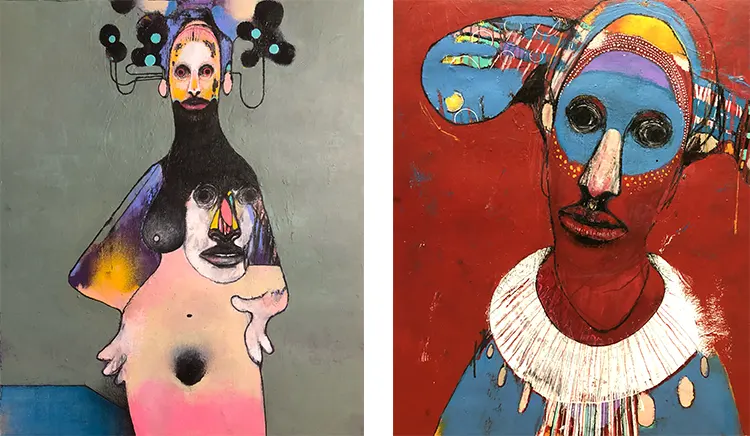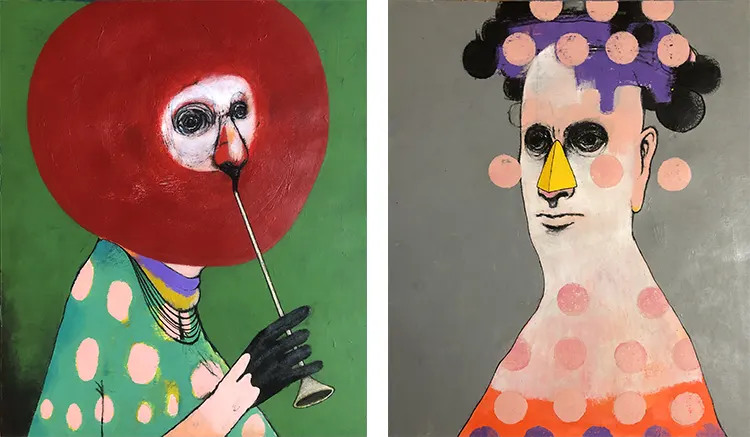“Anywhere is okay. I’d be even happier with cigarettes and coffee.”
Artistic Orientation and Thematic Focus: A Glimpse into Itaru Shimamura’s Work
The multifaceted and indelibly imaginative artist, Itaru Shimamura, hails from the enigmatic cultural landscape of Japan. His work unabashedly resonates with the energy of his homeland, as it is deeply steeped in the cultural ethos that define Japanese artistry. These profound nuances, albeit subconsciously integrated, permeate his creative oeuvre with remarkable intensity, their resonance profoundly manifest within the breadth and depth of his work.
Distinct influences are traced in Shimamura’s portfolio, from the atmospheric aesthetics of Ukiyo-e, the dramatic intricacies of manga, to the ethereal beauty of Buddhist statues. Equally captivating is his adept embrace of animation, which he weaves seamlessly into his artistic narrative. These elements converge, binding into an intricate tapestry that lays the groundwork for Shimamura’s artistic identity.
Shimamura himself has characterized his artistic journey as an enigma; a life both immersed in and detached from art. His artistic inspiration, he describes metaphorically, as the elusive gem hidden at the bottom of an undisturbed pond—unreachable unless the waters are drained. This captivatingly cryptic representation underscores the depth and complexity of his artistic process.
As such, Shimamura’s journey through artistry is best depicted as a curious paradox; always embodying the artist yet constantly striving towards an elusive artistic ideal. His is a voyage bathed in mystery, leading him down intriguing paths to arrive at his current standing in the world of art—a standing that is as deeply rooted in his Japanese heritage as it is distinctly etched in his unique artistic signature. His work thus provides a profound exploration of cultural energy transformed into vivid, tangible artistic expression, forever reminding us of the diverse origins of creative inspiration.

Finding Inspiration in the Mundane: Itaru Shimamura’s Creative Environment
Artistic orientation and thematic focus have a unique, albeit underexplored, dimension in the oeuvre of Itaru Shimamura. Despite the absence of a meticulously crafted stylistic ethos, Shimamura’s predilection for portraiture is unmistakable. This gravitational pull towards rendering human faces seems innate, a primal compulsion that has shaped the artist’s work since the earliest days of his creative journey. The inexplicable allure of portraiture in his oeuvre is testament to the individual’s magnetism in Shimamura’s artistic universe, wherein he strives to distill their essence through the stroke of his brush, even though the genesis of this concentration remains an enigma.
As for his creative environment, the artist’s adaptability is particularly noteworthy. Shimamura possesses a remarkable ability to transmute any setting into a creative sanctuary. He extracts inspiration from the mundanity of the everyday, finding a rhythm in the unpredictable. Yet, certain elements of comfort do punctuate his creative regime. The proximity of coffee and cigarettes, seemingly trivial, morphs into an ingredient for joy in the artist’s inventive equation. These habitual accessories form a symphony of senses that fuels his creativity, offering a layer of serene happiness that subtly permeates his work.
Shimamura’s approach towards distractions reveals yet another layer of his professional resilience. He acknowledges the inevitability of interruptions, but rather than capitulating to them, he engages with these disruptions as opportunities for growth. Each disturbance is met with a conscientious effort to realign focus, to cultivate presence, and to remain anchored in the creative flux. Such an attitude illuminates his commitment to his craft and reaffirms his dedication to maintaining artistic integrity amidst the chaos of the external world.

Ornette Coleman: A Catalyst in Itaru Shimamura’s Artistic Trajectory
Itaru Shimamura draws an integral part of his artistic inspiration from the legendary figure, Ornette Coleman. Coleman’s influential work has reverberated deeply within Shimamura, becoming an instrumental force in the shaping of his unique artistic trajectory. The impact Coleman has had on Shimamura is not only profound but also encourages the artist to continuously explore the limitless expanses of his creative boundaries.
Amongst the pantheon of artworks that resonate with Shimamura, one stands distinctively salient – “I’m alone even if I cough” by Hoya Ozaki (1185-1926). This particular haiku, even in its divergence from the traditional 5-7-5 syllable structure and the conspicuous absence of kigo, or seasonal words, is widely esteemed across Japan for its extraordinary spirit of unfettered freedom. Its magnetic allure stirred a deeper contemplation within Shimamura, coaxing him to grapple with the question of what truly delineates the merit of a haiku. It pressed him to critically analyze whether this renowned form of poetry could break its own conventional shackles and still birth something remarkable. Shimamura’s artistic philosophy finds resonance in such unconventional perspectives, which is clearly reflected in his own works.
This haiku by Ozaki offers a provocative yet enlightening perspective on the art of haiku, much like how Coleman’s innovative approach to music has influenced Shimamura’s artistic ventures. These two seemingly disparate sources of inspiration share a common thread of questioning and challenging the status quo, which has deeply impacted Shimamura’s artistic expression. It’s these influences that compel Shimamura to continually transcend traditional boundaries, fostering a bold and distinctive style that marks his unique footprint in the world of art.

Breaking Conventions: Haiku and Itaru Shimamura’s Artistic Philosophy
Itaru Shimamura nurtures an intense bond with his preferred mediums, including paper, acrylic paint, coloured pencils, and pens. These elements have crystallized into his emblematic style, an essential characteristic that frames his artistic voyage. Shimamura’s affinity for these mediums arises not merely from their practical perks, such as manageability or swift drying properties, but from a more profound, intimate kinship.
While Shimamura’s explorations with diverse artistic tools have offered him a broader palette of expression, these chosen mediums remain his primary artistic vernacular. They resonate most potently with his creative spirit. It’s as if these materials and the artist have come to comprehend each other’s peculiarities, subtleties, and rhythms, forming a tacit bond that distinctly resonates in the eloquence and impact of his artistry.
On the horizon of Itaru Shimamura’s creative vista, a grand project shimmers enticingly—a dream yet to be realized. This artistic endeavour involves the creation of a comprehensive art book, not a mere passive record but an animated narration of his aesthetic journey. Alongside this, Shimamura envisions a monumental sculpture, an imposing testament to his mastery of form and dimension. The third and equally important component of Shimamura’s dream project is a lively crowd, their bodies undulating rhythmically in a captivating dance.
This anticipated masterpiece mirrors Shimamura’s inventive approach to art, where diverse components synergize to create an immersive experience. Shimamura’s vision aims to merge the static and dynamic, the palpable and transitory, to fabricate a multi-sensory spectacle that doesn’t merely enthrall the eye but also engages and captivates the viewer on multiple dimensions. Indeed, this ambitious project encapsulates the comprehensive spirit of Itaru Shimamura’s artistry, a testament to his ceaseless quest to defy boundaries and transcend conventional artistic norms.






